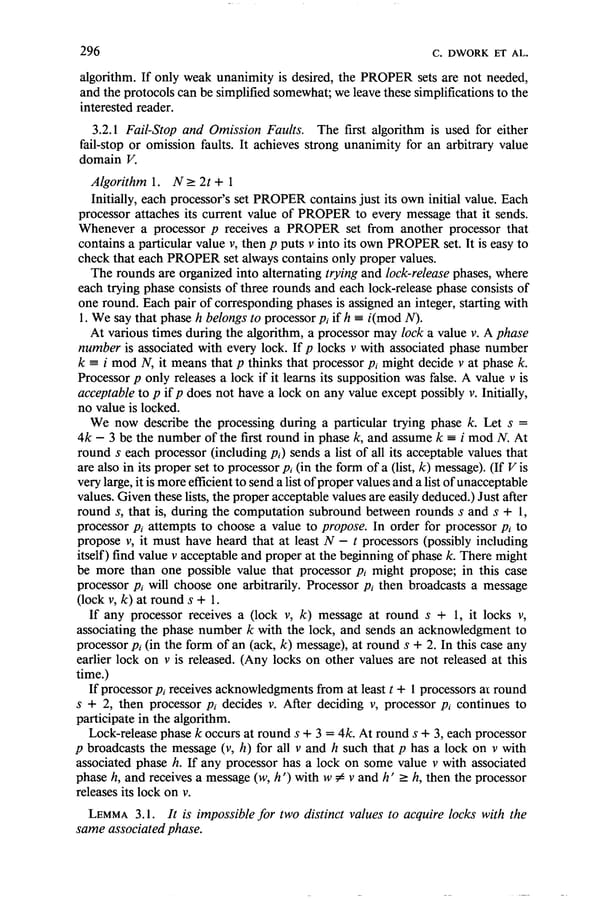296 C. DWORK ET AI,. algorithm. If only weak unanimity is desired, the PROPER sets are not needed, and the protocols can be simplified somewhat; we leave these simplifications to the interested reader. 3.2.1 Fail-Stop and Omission Faults. The first algorithm is used for either fail-stop or omission faults. It achieves strong unanimity for an arbitrary value domain V. Algorithm 1. N 2 2t + 1 Initially, each processor’s set PROPER contains just its own initial value. Each processor attaches its current value of PROPER to every message that it sends. Whenever a processor p receives a PROPER set from another processor that contains a particular value v, then p puts v into its own PROPER set. It is easy to check that each PROPER set always contains only proper values. The rounds are organized into alternating trying and lock-release phases, where each trying phase consists of three rounds and each lock-release phase consists of one round. Each pair of corresponding phases is assigned an integer, starting with 1. We say that phase h belongs to processor pi if h = i(mod N). At various times during the algorithm, a processor may lock a value v. A phase number is associated with every lock. If p locks v with associated phase number k = i mod N, it means that p thinks that processor pi might decide v at phase k. Processor p only releases a lock if it learns its supposition was false. A value v is acceptable to p if p does not have a lock on any value except possibly v. Initially, no value is locked. We now describe the processing during a particular trying phase k. Let s = 4k - 3 be the number of the first round in phase k, and assume k = i mod N. At round s each processor (including pi) sends a list of all its acceptable values that are also in its proper set to processor pi (in the form of a (list, k) message). (If V is very large, it is more efficient to send a list of proper values and a list of unacceptable values. Given these lists, the proper acceptable values are easily deduced.) Just after round s, that is, during the computation subround between rounds s and s + 1, processor pi attempts to choose a value to propose. In order for processor pi to propose v, it must have heard that at least N - t processors (possibly including itself) find value v acceptable and proper at the beginning of phase k. There might be more than one possible value that processor pi might propose; in this case processor pi will choose one arbitrarily. Processor pi then broadcasts a message (lock v, k) at round s + 1. If any processor receives a (lock v, k) message at round s + 1, it locks v, associating the phase number k with the lock, and sends an acknowledgment to processor pi (in the form of an (ack, k) message), at round s + 2. In this case any earlier lock on v is released. (Any locks on other values are not released at this time.) If processor pi receives acknowledgments from at least t + 1 processors at round s + 2, then processor pi decides v. After deciding v, processor pi continues to participate in the algorithm. Lock-release phase k occurs at round s + 3 = 4k. At round s + 3, each processor p broadcasts the message (v, h) for all v and h such that p has a lock on v with associated phase h. If any processor has a lock on some value v with associated phase h, and receives a message (w, h ‘) with w # v and h ’ 2 h, then the processor releases its lock on v. LEMMA 3.1. It is impossible for two distinct values to acquire locks with the same associated phase.
 Consensus in the Presence of Partial Synchrony Page 8 Page 10
Consensus in the Presence of Partial Synchrony Page 8 Page 10